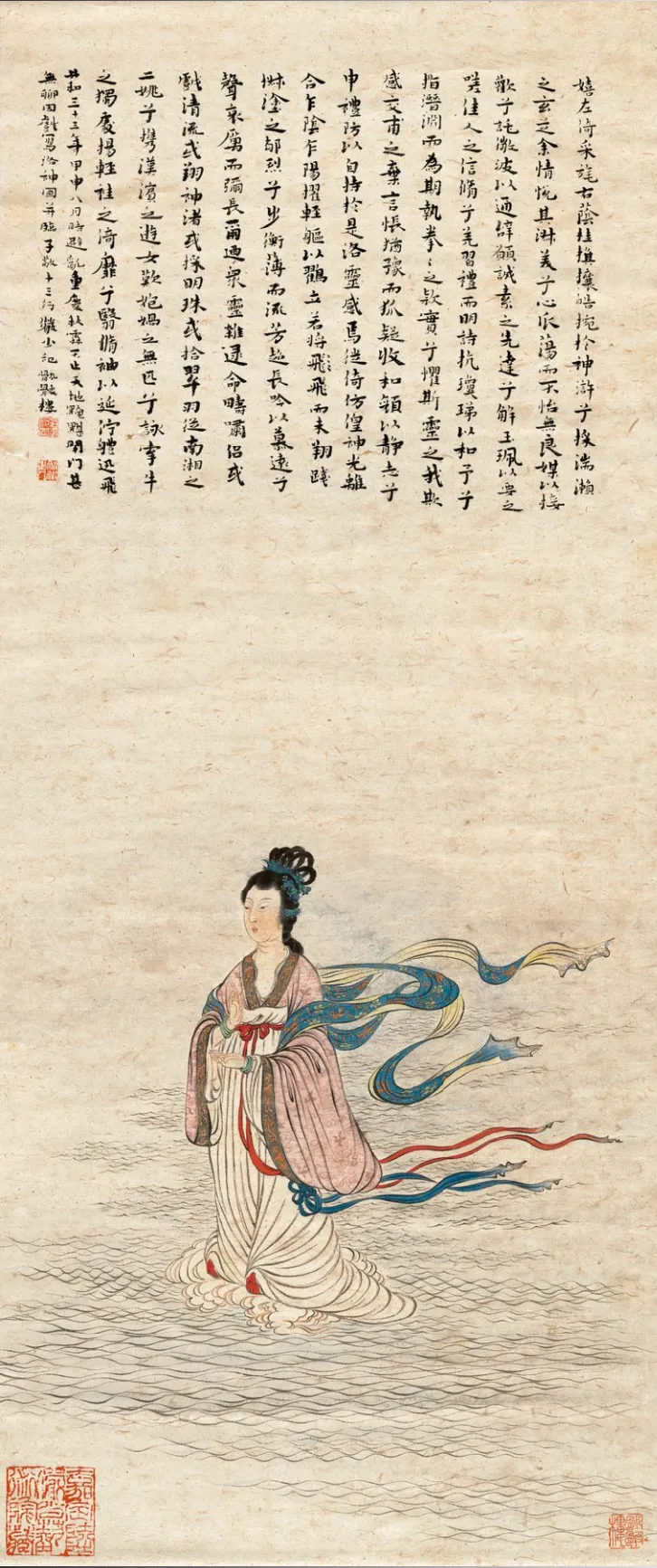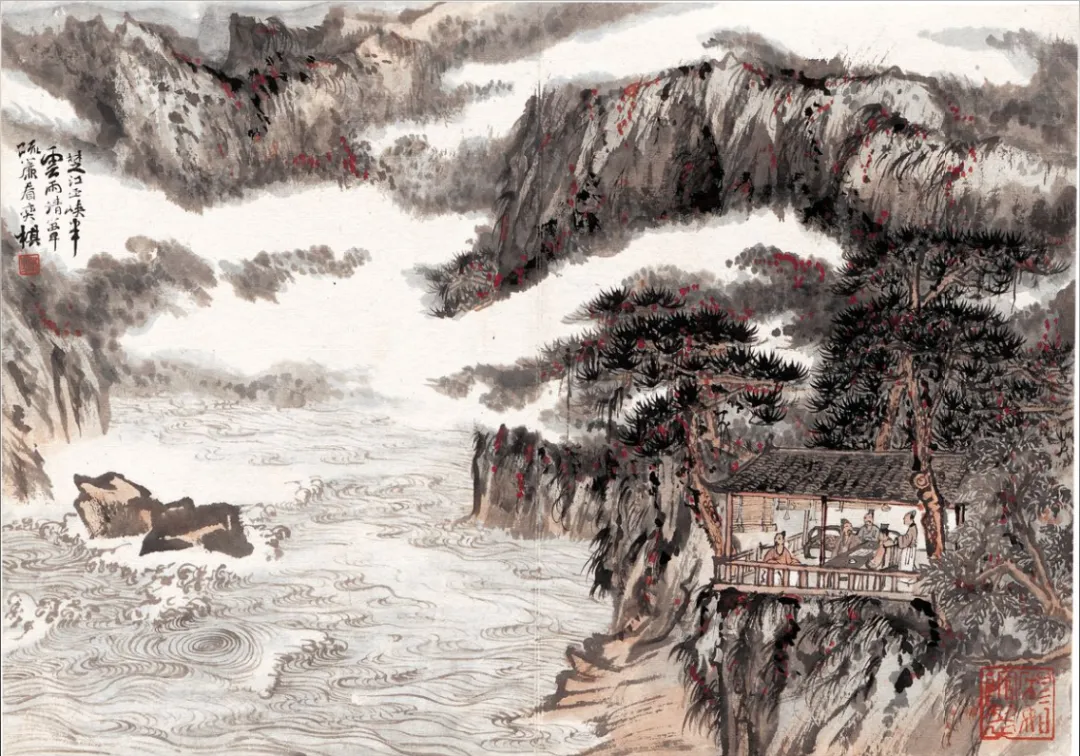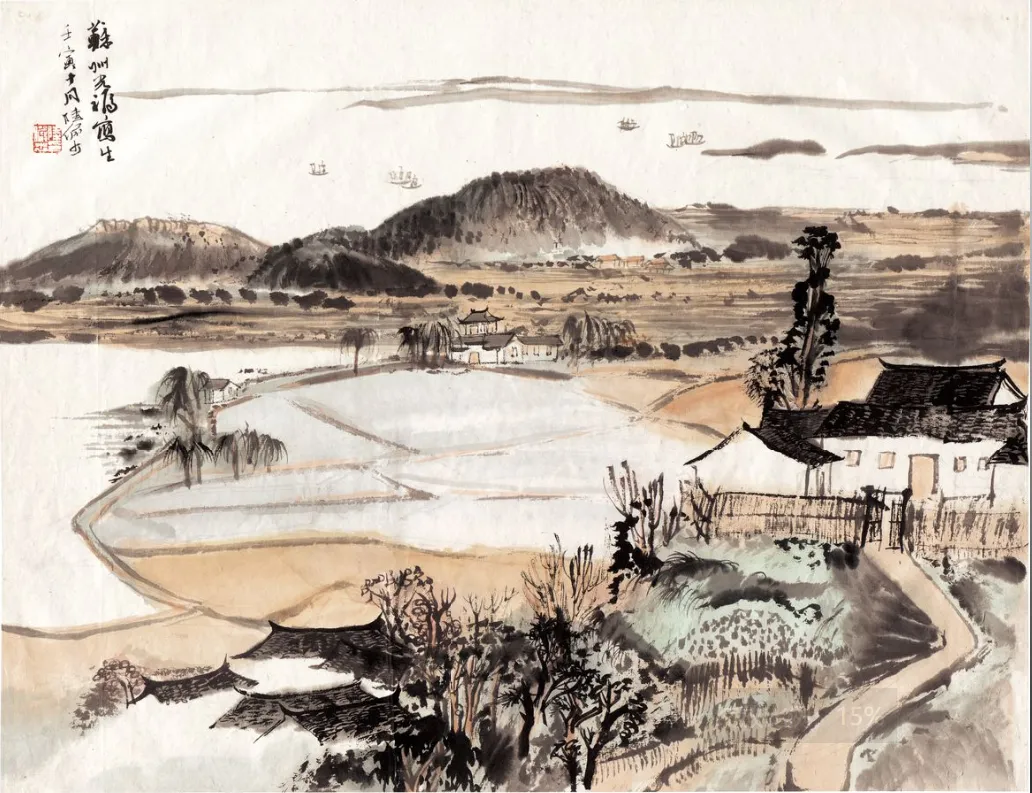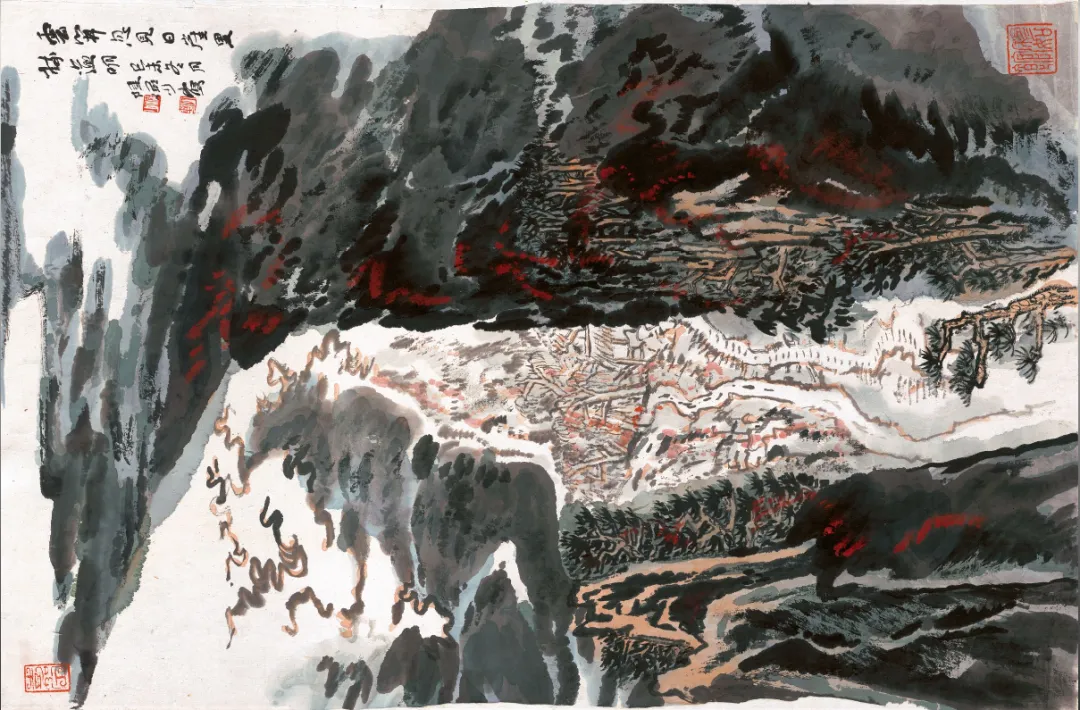陆俨少,甲子年六月廿六生于沪上嘉定之南翔,名砥,字宛若。商人之家,文墨传家,父韵伯,米店之主,文采风流,书法超群;外祖好书画,家中藏珍;母善刺绣,艺术之根,幼时已深植。
Lu Yanshao, born on June 26 of the Jiazi year in Nanxiang, Jiading, south of Shanghai, was named Di and styled Wanruo. Born into a family of merchants with a heritage in literature and ink, his father Yunbo, a rice shop owner, was noted for his elegant literary taste and exceptional calligraphy; his maternal grandfather was an aficionado of books and paintings, boasting a collection of treasures; his mother was skilled in embroidery, planting the seeds of art in him from an early age.

陆少好学,志在丹青,丙寅年入无锡美专,国画之学,诗文书法,同愈先生门下,冯超然为师,湖帆为友,南北胜地,游历不辍。新国既立,陆氏为上海画院之画师,浙江美院山水教习,己未年升教授,浙江画院院长,作《陆俨少画集》、《陆俨少书画集》等,艺术之花,绽放于世。癸酉年十月廿三,陆氏逝于沪上,春秋八十有四,艺术之魂,永存人心。
陆俨少善营幽境,工写山水,墨法多变,或用笔尖、肚、根,以呈山川气象之千态万端。线条之疏秀流转,刚柔并济,云水之技,尤为精妙,山势雄伟跌宕,云起雾涌,变幻无穷,且留白如大块墨斑,亦工人物、花卉,书法更独树一新。
陆氏深植革新之艺途。遗世独立,披览前贤之法而不泥于俗套。其以简驭繁,简章减理,广笔墨之对照,由圆蜕方,窃古人之神髓以启新意。其画,非徒仿效古人之轮廓,亦造形神兼备之境,真所谓运斤成风。居新安之岸,一遇雨霁,独坐悟空间之留白;三峡浩淼,观其险峻,自辟勾水之新径。由青绿厚重至意笔生花,开笔墨之新境,斯为不凡。与历代画匠異,彼等恒求均衡,以重心定于中央。陆氏则背常疏狂,轻重安于画隅,于将欲崩之际显动态之妙,图画因之生动,以显自然之流转无穷。
As a youth, Lu showed a keen interest in learning, with aspirations in painting and calligraphy. In the Bingyin year, he enrolled at the Wuxi Art School, studying traditional Chinese painting, literature, and calligraphy under the tutelage of Master Yu Xian, with Feng Chaoran as his teacher and Hu Fan as his companion. He traveled extensively across the landscapes of north and south. After the establishment of the new country, Lu served as a painter at the Shanghai Art Academy and taught landscape painting at the Zhejiang Art Academy. In the Jiwei year, he was promoted to professor and later became the head of the Zhejiang Art Academy. He authored works such as "Lu Yanshao's Painting Collection" and "Lu Yanshao's Calligraphy and Painting Collection," his artistic brilliance blossoming for the world to see. Lu passed away on October 23 of the Guiyou year in Shanghai, having reached the age of eighty-four, leaving his artistic spirit to live on eternally in the hearts of the people.
Lu Yanshao excelled in creating serene landscapes, adeptly painting mountains and waters with a versatile ink technique, employing the tip, belly, and base of the brush to depict the myriad forms of nature. His lines were elegantly fluid, balancing strength and softness. His mastery in depicting clouds and waters was particularly exquisite, creating imposing mountainous scenes with clouds and mists that changed endlessly. He was also skilled in portraying figures and flowers, and his calligraphy was uniquely distinguished.
Lu, outstanding and unparalleled, deeply embedded in the path of artistic innovation. Standing alone from the world, he explored the methods of the ancients without being bound by convention. Mastering complexity with simplicity, he reduced structures and broadened the contrast between ink and brush, transitioning from round to square forms, subtly capturing the essence of the ancients to forge new meanings. His paintings do not merely imitate the outlines of the past but also create a realm where form and spirit are equally captured, truly exemplifying mastery in motion.Residing by the banks of the Xin'an River, once, after a clearing rain, he sat alone, contemplating the art of leaving white spaces; observing the vast and perilous Three Gorges, he pioneered a new method for depicting water. Transitioning from the dense greenery of detailed brushwork to the flourishing strokes of freehand painting, he opened a new vista in the use of ink and brush, marking his uniqueness. Unlike traditional painters who always strive for balance, positioning the focal point at the center, Lu Yanshao embraced an unconventional boldness, placing emphasis on the edges of his canvases. At moments nearing collapse, he revealed the beauty of movement, bringing the paintings to life and displaying the endless transformations of nature.


春到人间

怀素书蕉

东蒙隐居图

杜甫詩意冊

仿明人笔意图

洛神图

梅石图

楚江巫峡半云雨

地平一川稳

光福镇

新会圭峰招待所

云开忽见日

云气出虚壁

楚畹遗芳

仿倪云林图
画家常以大始小终,陆氏则反其道而行之,由小及大,笔笔生机,无初稿,积小面而成大面。画作中,忽逢思绪之断,转瞬即是柳暗花明,绝境逢生,又显新境界。其画之框架,以浓墨为骨架,渐入淡墨,由润而燥,常以生辣之笔起首,继之干笔淡墨皴擦,先一笔为“启”,后一笔为“随”,“启”为主,后笔因前笔之大细、浓淡、干润而补之,笔笔相继,如波涌潮汐,连绵不绝。陆氏作画,从不事前绘草,虽巨幅亦只大体定位,随心所欲,笔走神驰,奇思妙想,源源而至。
陆俨少承继山水之统,而以笔墨为驭,发挥至苍劲多变之域。其法自青绿入披麻、折带、卷云、牛毛,复及斧劈、乱柴,皆运笔于致意之际,点染之中,神游物外,化入无间。
陆氏于七十年代启留白篇章,于山水间布白,如云岚雾光,飘渺于峰峦,白山相间,雾绕风回。至八十年代,施粗笔之风,而求变革于安定之中,再历艺途变迁,简笔墨而除景繁,使画风雄浑而不失敏捷,意境愈显清晰,风格自成一脉。
陆氏之笔,敢于从简,用色简约而非凡,探笔墨之奥妙,以简驭繁,创出清新而雄浑之画境。其作气韵生动,融古今之独特风致,开清新明朗而兼具恣肆气魄之新艺境。
Unlike other painters who often started with broad strokes and finished with details, Lu adopted the opposite approach. He started with the small and worked towards the larger scale, each stroke brimming with life, without any preliminary drafts, gradually building up smaller sections into a larger whole. In his creative process, moments of sudden inspiration would often lead to breakthroughs, transforming challenges into new vistas. His painting framework employed dense ink as the skeleton, transitioning into lighter ink, moving from moist to dry, starting with vigorous bold strokes and then using dry, light brushwork for texturing. The initial stroke, known as "initiation," set the tone, followed by subsequent strokes, known as "follow-up," which were adjusted based on the characteristics of the initial stroke in terms of size, density, moisture, and speed, creating a continuous, wave-like rhythm. Lu painted without preliminary sketches, positioning broadly even for large works, allowing his brush to move as inspired, his innovative ideas flowing ceaselessly.
Lu Yanshao inherited the tradition of landscape painting but commanded the brush to explore the realms of vigorous and varied techniques. He incorporated methods such as rubbing, folding, rolling clouds, and even more abrupt techniques like ax splitting and chaotic wood texturing, applying his brush spontaneously at moments of inspiration, transcending the physical to reach the metaphysical seamlessly.
In the 1970s, Lu initiated a new chapter with his technique of leaving white spaces within his landscapes. These whites, resembling clouds, mist, haze, or sunlight, floated ethereally among the mountains, alternating layers of landscape with layers of white, creating a rhythmic interplay of visibility and obscurity. By the 1980s, under his "bold brush" style, he continued to seek change within stability. During this period, his artistic journey underwent another transformation, simplifying brush and ink use, reducing complexity in the scenes, which rendered his style both robust and agile, clarifying the artistic conception and establishing a distinctively new style.
Lu's approach to painting was bold in its simplicity, employing a restrained palette that nevertheless achieved remarkable effects. He delved into the expressive potential of brush and ink, using simplicity to manage complexity, thus creating a fresh yet majestic landscape. His works vibrated with life and uniquely blended ancient and modern styles, forging a new artistic realm that was both refreshingly clear and boldly assertive.

——“陆俨少氏,天才学力皆可观。”(国画家、书法家黄宾虹评)
"Lu Yanshao is a genius, both in terms of his academic and artistic talents." (Commented by Huang Binhong, a painter and calligrapher)
——“吾友陆俨少之山水画,法取宋元、变之明清。既得古人之神髓,复积数十年之经验,简练揣摩,履薄临探,兼百家之长,各去其短,遂自成体例。俨少山水,缜密而不失浑厚,娟秀不失老辣。山功、水流、云飞,庶读者能一见生机。尤为兴叹者,画中一笔一墨,无不来自前人却又教人不能察辨其所从出。古今画苑,殊不多见。”(画家谢稚柳评)
"My friend Lu Yanshao's landscape paintings draw upon the techniques of the Song and Yuan dynasties and transform them through the Ming and Qing styles. He has captured the essence of the ancient masters and, after decades of experience, has refined his observation and understanding, exploring delicately and deeply, combining the strengths of various schools while discarding their shortcomings, thus forming his own unique style. Lu Yanshao's landscapes are meticulous yet robust, delicate without losing a seasoned vigor. His depiction of mountains, the flow of water, and the flight of clouds instantly brings the scene to life for the viewer. Most astonishingly, each stroke and each drop of ink in his paintings originate from the ancients yet make it impossible for one to discern their exact sources. Such a feat is indeed rare in the annals of both ancient and modern painting." (Critique by the painter Xie Zhiliu)
责任编辑:苗君